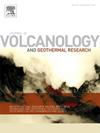Reconstructing the volcanic history of the Ulukışla Caldera: A collapse structure within the Hasandağ Volcanic Complex, Central Anatolia (Turkey)
IF 2.3
3区 地球科学
Q2 GEOSCIENCES, MULTIDISCIPLINARY
Journal of Volcanology and Geothermal Research
Pub Date : 2025-04-16
DOI:10.1016/j.jvolgeores.2025.108345
引用次数: 0
Abstract
The Ulukışla Caldera is a collapse structure within the active Hasandağ Volcanic Complex (Central Anatolia), situated along the southern branch of the Tuz Gölü Fault Zone (TGFZ). This study aims to reconstruct the volcanic history of the Ulukışla Caldera by characterising its associated pyroclastic deposits using tephrostratigraphy, glass chemistry (major and trace elements), and geochronological data (40Ar/39Ar and U-(Th)-Pb). Our findings reveal that the Ulukışla Caldera has undergone at least three major explosive rhyolitic eruptions, which formed the pyroclastic deposits of the Yenipınar Eruption (∼442 ka), the Belbaşhanı Eruption (∼400 ka), and the Ulukışla Eruption (∼326 ka). The Yenipınar unit was produced by an unsteady eruption column originating from paleo-Ulukışla volcanic structure, that deposited pumice fallout layers and interbedded pyroclastic density current (PDC) deposits. The Belbaşhanı Eruption began with a Plinian column that deposited the Belbaşhanı Pumice fallout. This phase was followed by the emplacement of thick PDC deposits and co-ignimbrite lithic lag breccias during the collapse, which ultimately led to the formation of the Ulukışla Caldera. The volume of the Belbaşhanı deposits, including the pumice fallout and the caldera-forming ignimbrite, could reach up to 10 km3 DRE (Dense Rock Equivalent), corresponding to an eruption of magnitude ∼6. The Ulukışla Pumice resulted from a post-caldera eruption, which did not generate PDCs. The Ulukışla Caldera exhibits an elongated morphology, which is strongly influenced by the NW-SE alignment of the TGFZ. Based on this morphology and the regional tectonic setting, we conclude that the Ulukışla Caldera is a strike-slip/graben caldera. Reconstructing the volcanic history of this newly identified caldera is essential for enhancing our understanding of the Hasandağ Volcanic Complex. Our findings offer valuable context for future eruptive behaviour, improving the hazards assessment for potential caldera collapses, and contribute to mitigating associated risks.
重建Ulukışla火山口的火山历史:土耳其安纳托利亚中部哈桑达尔火山群的崩塌结构
Ulukışla火山口是位于Tuz Gölü断裂带(TGFZ)南部分支的活跃的哈桑达尔火山群(安纳托利亚中部)内的一个崩塌结构。本研究旨在利用地层、玻璃化学(主要元素和微量元素)和年代学数据(40Ar/39Ar和U-(Th)- pb)对Ulukışla破火山口的火山碎屑沉积进行表征,重建其火山历史。研究结果表明,Ulukışla破火山口经历了至少三次大的流纹岩爆发,形成了Yenipınar喷发(~ 442 ka)、belba hanhai喷发(~ 400 ka)和Ulukışla喷发(~ 326 ka)的火山碎屑沉积。Yenipınar单元是由发源于paleo-Ulukışla火山构造的不稳定喷发柱形成的,形成浮石沉降层和互层火山碎屑密度流(PDC)矿床。贝尔ba汉伊火山爆发始于一个普林尼柱沉积了贝尔ba汉伊浮石沉降物。在这一阶段之后,在崩塌过程中,厚PDC矿床和co-ignimbrite岩屑角砾岩侵位,最终形成了Ulukışla破火山口。包括浮石沉降物和形成火山口的火成岩在内的belbahanza矿床的体积可达10 km3 DRE(致密岩石当量),相当于一次6级的喷发。Ulukışla浮石是由火山口喷发后形成的,没有产生pdc。Ulukışla破火山口呈现出细长的形态,受TGFZ北西-东南走向的强烈影响。根据这一形态和区域构造背景,我们认为Ulukışla破火山口为走滑/地堑破火山口。重建这个新发现的火山口的火山历史对于增强我们对哈山达尔火山群的理解至关重要。我们的发现为未来的喷发行为提供了有价值的背景,改善了潜在火山口崩塌的危害评估,并有助于减轻相关风险。
本文章由计算机程序翻译,如有差异,请以英文原文为准。
求助全文
约1分钟内获得全文
求助全文
来源期刊
CiteScore
5.90
自引率
13.80%
发文量
183
审稿时长
19.7 weeks
期刊介绍:
An international research journal with focus on volcanic and geothermal processes and their impact on the environment and society.
Submission of papers covering the following aspects of volcanology and geothermal research are encouraged:
(1) Geological aspects of volcanic systems: volcano stratigraphy, structure and tectonic influence; eruptive history; evolution of volcanic landforms; eruption style and progress; dispersal patterns of lava and ash; analysis of real-time eruption observations.
(2) Geochemical and petrological aspects of volcanic rocks: magma genesis and evolution; crystallization; volatile compositions, solubility, and degassing; volcanic petrography and textural analysis.
(3) Hydrology, geochemistry and measurement of volcanic and hydrothermal fluids: volcanic gas emissions; fumaroles and springs; crater lakes; hydrothermal mineralization.
(4) Geophysical aspects of volcanic systems: physical properties of volcanic rocks and magmas; heat flow studies; volcano seismology, geodesy and remote sensing.
(5) Computational modeling and experimental simulation of magmatic and hydrothermal processes: eruption dynamics; magma transport and storage; plume dynamics and ash dispersal; lava flow dynamics; hydrothermal fluid flow; thermodynamics of aqueous fluids and melts.
(6) Volcano hazard and risk research: hazard zonation methodology, development of forecasting tools; assessment techniques for vulnerability and impact.

 求助内容:
求助内容: 应助结果提醒方式:
应助结果提醒方式:


